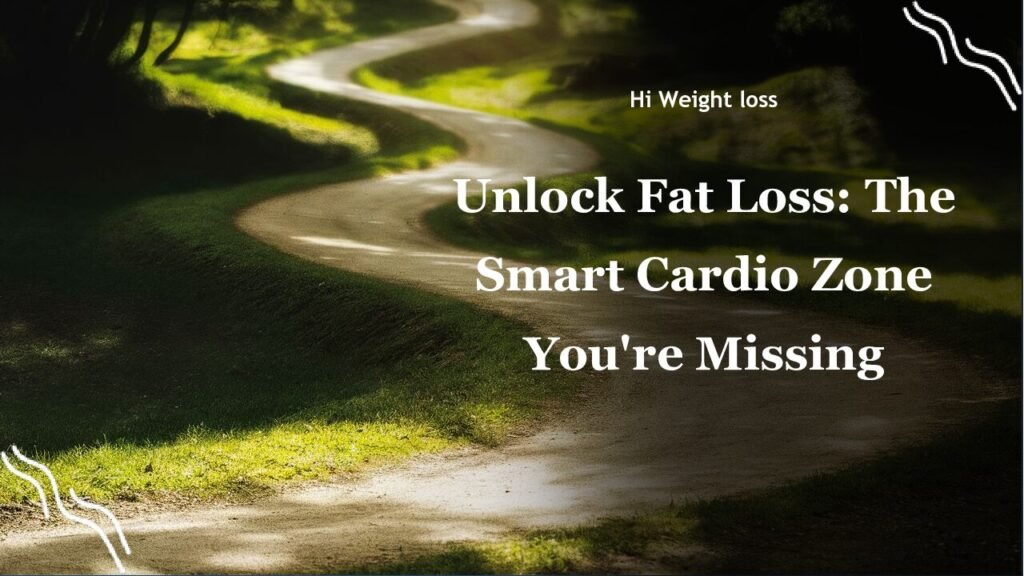Are you struggling to lose weight, feeling like you’re putting in the hours at the gym with little to show for it? It’s frustrating, isn’t it, to spend all that energy and not see the results you’re hoping for. Maybe you’ve been pushing yourself to the max with high-intensity workouts, thinking that’s the key to fat loss. But what if I told you there’s a more effective way? This article will dive deep into the best cardio zone for fat loss, revealing how targeting the right heart rate can actually make a big difference. We’ll explore the science behind it and share some personal experiences to help you on your weight loss journey.
Which Cardio Zone Is Best for Fat Loss?
The quest for effective fat loss often leads us to the gym, but it’s not always about how hard you work, it’s about how smart you work. You might think high-intensity training is the only path to shedding pounds, but science suggests there’s a specific heart rate zone where your body burns fat most efficiently. This magical zone? It’s often referred to as Zone 2.
Understanding Heart Rate Zones for Fat Burning
Heart rate zones are based on percentages of your maximum heart rate (MHR). Your MHR is roughly calculated as 220 minus your age. Each zone corresponds to different levels of exertion and metabolic fuel usage. Zone 2, often cited as the _optimal heart rate for fat loss_, falls within 60-70% of your maximum heart rate. Why is this range so significant?
I remember when I first started focusing on my heart rate, I was all over the place, jumping between zones and wondering why I was so exhausted but not losing weight. A fitness instructor at my gym explained that Zone 2 is where my body would use fat as a primary fuel source, and it was a game-changer. It wasn’t about pushing myself to the absolute limit. Instead, I learned to maintain a steady pace. The key is to be able to hold a conversation whilst doing cardio. If you can’t hold a conversation, you’re probably not in zone 2.
The Science Behind Zone 2 and Fat Loss
During Zone 2 cardio, your body taps into its fat reserves for energy. This is in contrast to higher intensity workouts where your body relies more on glycogen (stored carbohydrates). Think of it as your body reaching for the long-term fuel supply instead of the quick fix. This makes Zone 2 a powerful tool when targeting fat loss, because as explained by _EW Motion Therapy_, the body uses more stored fat as its primary energy source at this intensity level.
Furthermore, at this intensity, your body can sustain activity for much longer periods. This longer duration of exercise often leads to a higher total calorie burn. It’s also an important point, because as pointed out by _Mayo Clinic_, Zone 2 training also helps improve your overall cardiovascular fitness, which can be hugely beneficial for both overall health and any weight loss goals.
My friend, Sarah, told me how she had always assumed that the harder she went, the better. After seeing her energy levels crash and struggling to keep up with her HIIT workouts, she switched to Zone 2 training. She was amazed at how much longer she could exercise and, over time, started to see the fat loss results she wanted. It’s not necessarily that HIIT is ‘bad’, it just isn’t always the most effective way for sustained fat loss.

How to Determine Your Zone 2 Heart Rate
Ready to figure out your _heart rate zones for fat burning_? Here’s a simple method you can use. First, estimate your maximum heart rate (MHR) by subtracting your age from 220. For example, if you’re 40, your estimated MHR would be 220 – 40 = 180 bpm (beats per minute). Your Zone 2 heart rate range is typically between 60% and 70% of your MHR.
To calculate the lower end of your Zone 2 range, multiply your MHR by 0.60. For our example, this would be 180 _ 0.60 = 108 bpm. For the upper end of Zone 2, you multiply your MHR by 0.70, so 180 _ 0.70 = 126 bpm. So, if you are 40, your Zone 2 heart rate range would be roughly 108-126 bpm. You’ll want to stay within this zone to optimize fat burning.
However, you can also use some wearable devices to track your heart rate whilst training. I have personally found them very beneficial. They help me to ensure I am in Zone 2 during my cardio workouts. You should always consult a healthcare professional before starting a new exercise plan. It’s important to ensure that what you’re doing is safe and appropriate for you.
The “Fat Burning Zone” – Is It Really That Simple?
While Zone 2 is excellent for encouraging your body to burn fat as fuel, it’s essential to understand that the idea of a single “fat-burning zone” is a little oversimplified. As _AARP_ points out, the percentage of fat burned during exercise is not the sole determinant of weight loss. The total number of calories burned is often more crucial.
For instance, a high-intensity workout might burn fewer fat calories during the activity itself, but the ‘afterburn’ effect, where your body continues to burn calories at a higher rate post-exercise, can lead to a significant impact on overall weight loss. Ultimately, the goal is to create a calorie deficit, where you burn more calories than you consume.
I remember speaking with a nutritionist about my goals and she highlighted the importance of looking at the bigger picture. She said, “It’s not just about the calories burned during the workout, it’s about the long-term impact on your metabolism and overall energy balance”. This conversation really changed the way I looked at cardio.
Practical Ways to Implement Zone 2 Cardio
Now that you understand the theory, how do you practically implement Zone 2 cardio? Any form of cardio that you enjoy and can sustain is a great option. Whether it’s brisk walking, jogging, cycling or swimming, you can adjust the intensity to keep you within that ideal heart rate range.
My preferred method is cycling, because I can easily maintain a consistent pace and monitor my heart rate. What you do should depend on what you find enjoyable. Consistency is key! Aim for at least 30 minutes, most days of the week. You can also break up your cardio into shorter 10-15 minute sessions if you don’t have a large chunk of time in the day.
You should also use a heart rate monitor. This could be a chest strap, a wrist-based device, or a fitness watch. These devices will give you real-time feedback, allowing you to stay in the zone. If your heart rate is too high, slow down; If it’s too low, increase your pace. I found using a fitness watch really helpful as I can see what zone I am currently in.
Combining Zone 2 With Other Types of Training
While Zone 2 cardio is great for fat loss, you can combine it with other forms of exercise for more holistic results. Consider incorporating strength training a few times a week, as building muscle mass can boost your metabolism. This is something I have personally found extremely useful when I started incorporating it into my fitness regime.
High-Intensity Interval Training (HIIT) can also be effective when used in moderation, especially for improving cardiovascular fitness and calorie expenditure. The key is to achieve a balance that suits your body and your personal fitness goals. Remember to always listen to your body, and rest when needed.
Here is a table summarizing these heart rate zones:
| Heart Rate Zone | % of Max Heart Rate | Primary Fuel Source | Benefits |
|---|---|---|---|
| Zone 1 (Very Light) | 50-60% | Primarily Fat | Warm-up, recovery |
| Zone 2 (Light) | 60-70% | Mainly Fat | Fat loss, endurance |
| Zone 3 (Moderate) | 70-80% | Carbohydrates & Fat | Improved aerobic fitness |
| Zone 4 (Hard) | 80-90% | Primarily Carbohydrates | Improved performance, speed |
| Zone 5 (Maximum) | 90-100% | Carbohydrates | Maximum performance, short bursts |
Conclusion
Navigating the world of fat loss can feel overwhelming with so many conflicting messages. However, understanding the principles of heart rate training, particularly how Zone 2 promotes fat burning, can be transformative. Remember, it’s not always about the intensity but about sustained, consistent effort. Like my experience, focusing on Zone 2 cardio helped me discover that you can achieve great results without having to always push yourself to exhaustion. While it’s not the only thing to consider, as _Cosmopolitan_ mentions, focusing on your _heart rate zones_ can be hugely beneficial when working towards fat loss.
So, what’s your next step? Perhaps try a Zone 2 workout today? Start with a brisk walk and see how it feels. Try tracking your heart rate and monitor your progress. Share your experience with friends, or get them involved in your fitness journey. By making small, consistent changes you can get the results you are looking for.
FAQ
How often should I do Zone 2 cardio?
Aim for at least 30 minutes, most days of the week. Consistency is key for any fitness regime. You should listen to your body and take breaks when you feel that you need to.
Can I lose weight with only Zone 2 cardio?
Yes, it can be very effective. Zone 2 training encourages your body to burn fat as a primary fuel source. It is, however, important to incorporate strength training and other forms of exercise to ensure you are living a balanced and healthy lifestyle.
Do I need special equipment to do Zone 2 cardio?
You don’t need any special equipment, a heart rate monitor can be helpful, but you can start with what you have available. Use your wearable device, or monitor it manually. Remember, consistency is more important than always having the latest equipment.
How long does it take to see results with Zone 2 cardio?
Everyone is different, but with consistency and proper nutrition, you should start seeing results in a few weeks. Make sure you are taking regular measurements and note how you feel, too. Remember, it is a marathon, not a sprint.
Can I do Zone 2 cardio every day?
You can, if your body feels good with it. It’s always advisable to incorporate some rest days as well. Always listen to your body and adjust your training accordingly.



